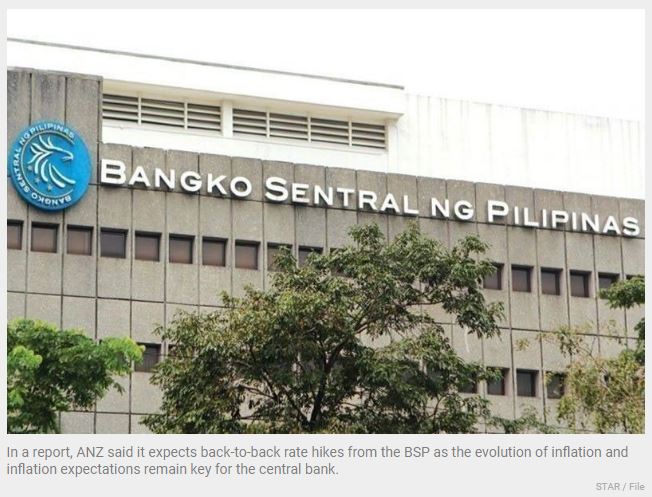Philippines: BSP seen hiking rates until Q1 next year
MANILA, Philippines —The Bangko Sentral ng Pilipinas (BSP) may raise its interest rates gradually by 25 basis points until the benchmark rate hits four percent in the first quarter of 2023 to anchor inflation expectations, according to ANZ Research.
In a report, ANZ said it expects back-to-back rate hikes from the BSP as the evolution of inflation and inflation expectations remain key for the central bank.
“We expect back-to-back rate hikes until first quarter of 2023 when a terminal rate of four percent will be reached,” ANZ said.
The BSP has raised its key policy rates by 50 basis points with a back-to-back 25-basis-point rate hikes that brought the overnight reverse repurchase rate to 2.50 percent from an all-time low of two percent.
The central back started its interest rate liftoff on May 19, when it delivered a 25-basis- point rate hike, the first in more than three years or since November 2018, to curb rising inflationary expectations.
“The central bank’s relatively modest hiking cycle will see real interest rates dip further into negative territory, weighing on bonds,” ANZ said.
The BSP also hiked its inflation forecasts to five percent for 2022 and to 4.2 percent for 2023 due to higher inflation outturns as well as soaring global oil and non-oil prices.
Inflation averaged 4.1 percent in the first five months, exceeding the BSP’s two to four percent target after quickening to 5.4 percent in May from 4.9 percent in April.
“By its own assessment, headline inflation will only fall back within the official two to four percent target range by the second quarter of 2023,” ANZ said.
After exiting the pandemic-induced recession with a GDP growth of 5.7 percent last year, the Philippines sustained the strong growth with an expansion of 8.3 percent in the first quarter.
“First quarter GDP growth rebounded to its pre-pandemic level, but the cumulative output gap remains. Although further improvement is likely in the near term, the growth outlook for the second half of 2022 and beyond has become more challenging against the backdrop of widening external imbalances and a rapid deterioration in the domestic inflation outlook,” ANZ said.
The investment bank sees the Philippines booking a GDP growth of 6.7 percent this year and 5.8 percent next year.
Both projections are lower than the targets set by the Cabinet-level Development Budget Coordination Committee (DBCC) of seven to eight percent this year and six to seven percent next year.
On the peso, ANZ sees the local currency ending 2022 at 54 to $1 before rebounding to 53 to $1 in 2023 as near-term challenges are increasing for the peso, with the Philippines facing a rising external account deficit and an aggressively hiking US Federal Reserve.
ANZ said that domestic demand would remain high due to a strong government spending program, while import growth would continue to outstrip exports and lead to a further deterioration in the external position, pushing the currency lower.
“As a result, the risks are tilted towards a steeper depreciation of the peso, and we expect it to stay on the weaker side in 2022,” ANZ said.
Source: https://www.philstar.com/business/2022/06/27/2191094/bsp-seen-hiking-rates-until-q1-next-year-


 Thailand
Thailand




